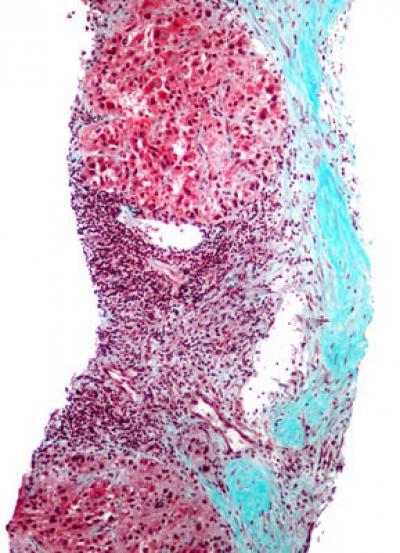Researchers have isolated and characterized the progenitor cells that eventually give rise to malignant hepatocellular carcinoma (HCC) tumors – the most common form of liver cancer. The researchers found ways to identify and isolate the HCC progenitor cells (HcPC) long before actual tumors were apparent.
Principal investigator Michael Karin, PhD, Distinguished Professor of Pharmacology and Pathology at the University of California, San Diego School of Medicine, and colleagues report that HcPC take form within dysplastic or abnormal lesions often found in damaged or cirrhotic livers. The liver damage can be due to viral infections like hepatitis or from chronic alcohol abuse.
The researchers were able to characterize HcPC based on several biomarkers that distinguish them from normal cells. They also identified cellular signaling pathways activated in HcPC that are critical 'to their malignant potential.'

A stained liver biopsy micrograph showing hepatocellular carcinoma cells with Mallory bodies (reds and blacks). Credit: UCSD
"It was never established whether dysplastic lesions are just a regenerative (healing) response of the liver triggered by tissue damage or are actually pre-malignant lesions that harbor tumor progenitor cells," said study co-author Debanjan Dhar, PhD, a postdoctoral researcher in Karin's lab. "Here we show that HcPC are likely derived from dysplastic lesions, can progress to malignant tumors and further demonstrate that the malignant progression of HcPC to full-blown liver cancer depends upon the microenvironment that surrounds them."
The findings may have profound implications for treating HCC which, while relatively rare in the United States compared to other types of cancer, is difficult to diagnose and treat, with poor prognoses for patients. HCC is usually fatal within three to six months of diagnosis, according to National Institutes of Health data. An estimated 30,000 new cases of liver cancer are diagnosed annually in the U.S., predominantly among men. More than 21,600 Americans die from liver cancer each year, a rate that has been rising slowly for several decades. In other parts of the world, HCC is a major cause of cancer-related deaths.
Most cancers are best detected and treated at the earliest possible stage. HCC is problematic because it develops slowly and frequently displays no symptoms. By the time it is detected, said Dhar, it is usually at an advanced stage with no effective therapy.
"Our findings can be translated into both early detection and therapeutic intervention," he said. "Better understanding of HcPC cellular networks will provide us with new and effective therapeutic targets."
For example, the researchers were able to detect "potential" malignant lesions in needle biopsies of a subset of patients infected with the hepatitis C virus, but who hadn't yet developed HCC. Hepatitis C is a major risk factor for HCC development.
Dhar said identifying premalignant lesions in high-risk patients based on HcPC markers would allow for earlier detection and therapeutic interventions. "Furthermore, in future, therapies can be developed to specifically eliminate the HcPC even before a tumor has developed."
Published in Cell.





Comments